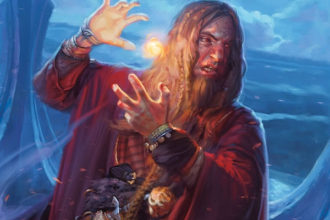Blade – Taking Lessons from Marvel’s Best Film
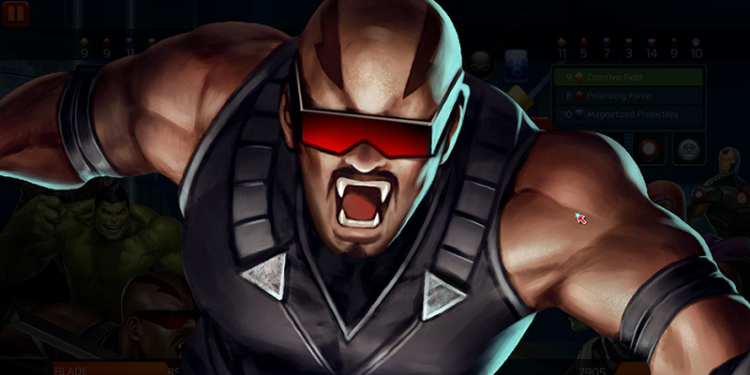
It’s a known quantity that I am both a nerd and love movies. It’s only natural that people believe that I would obviously be interested in all of the Marvel movies – it’s sort of a nerd event horizon. When I give my answer, people blink at me, laugh in a vaguely uncomfortable way, and then ask, “no, seriously.” When I tell them I am not joking, they always end up asking about the current run of movies – my answer there is Iron Man 3, don’t @ me – but that doesn’t change the fact that the real answer is my first one: Blade is the best Marvel movie. Yes, the 1998 Wesley Snipes movie that features a character who began as a blaxploitation character and was noted for “Marvel Black” dialogue at the start of his run. Blade is not only the best Marvel film by far – BY FAR – but also offers us unique insights into story that we can use in running games that goes beyond what is offered from other superhero films – Iron Man 3 not withstanding.
Before we get into the film itself, we need to appreciate his comic roots. This isn’t critical to the film, but it’s a glimpse into comic life in the 70’s and deserves some discussion. Back in olden times – in the long, long ago – horror comics weren’t really a thing. The Comic Code Authority – the governing body of comic publication from the 1950’s to the late 1990’s-ish – had a ban on all horror comics – including the appearance of vampires. This was rescinded in 1971, allowing vampires, werewolves, and other supernatural beasties – particularly public domain ones – to enter the comic world. It only makes sense that Dracula was one of the first baddies to get the comic treatment.
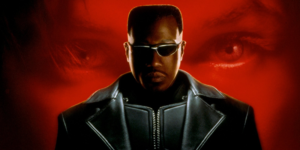
The Tomb of Dracula began its run in April 1972 – a comic book following the adventures of the descendants of classic vampire-related characters. The group was lead by Quincy Harker – son of Jonathan and Mina – Rachel van Helsing – who was assuredly better than Vanessa van Helsing – and Frank Drake – human descendant of Dracula. In Tomb of Dracula #10 this group encountered Blade – a child who was born after his mother transformed into a vampire during childbirth, thanks to being attacked by the vampire Deacon Frost. This oddity of birth afforded him immunity to traditional vampirism and their tricks, superhuman speed, agility, strength, healing, and all that other good stuff associated with vampires – ok this is from a more-different vampire bite he received, but really these aspects became part of his iconic identity. He also doesn’t suffer any of the traditional vampire drawbacks. This all makes him more of the dhampir from Slavic folklore – and into the Blade we know and love from the films.
Blade was also a product of his time. He began life with an afro and spoke in cliches. He was taught combat by Jamal Afari, an old jazz musician – whose life was destroyed by drug abuse. His mother was a prostitute. He joined street gangs, became a phenomenal athlete, never knew his real father, and got named Blade because he was so skilled with sharp implements. He’s a black man on the outside because he’s mixed race, who has to consistently redefine himself to embrace either side of his heritage. While the comic was set in the past and into the present, there is no denying Blade was a product of being black in the 1970s.
The movies updated Blade, changing him while adhering to the source in meaningful ways. Instead of being born London in the 20’s, he’s born in Detroit in 1967 – an important year to set an origin that revolves around violence against a black woman in an urban environment. His mentor was changed from Jamal Afari to Abraham Whistler – an obvious nod to Abraham van Helsing (who was so named by author Abraham “Bram” Stoker). While not explicitly stated, it is very likely Abraham Whistler is Jewish, adding a different – yet still similar – facet to the nature of his adoption and moving it in a direction that is different than it could otherwise be by replacing a black character with a white character. The history of “white” when it comes to Judaism is a complex one, to say the least. The movie also leaves out all mentions of Morbius the Science Vampire that turned Blade into the dhampir we know and love – and for good reason. Just like the comics, Blade is a product of his times – this time the 90’s. He’s got a katana instead of wooden weapon, he wears a leather trench coat, rocks sunglasses, and so on. He’s ultra 90’s, and it’s rad.
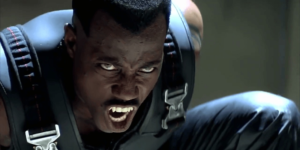
This is something of a long introduction, but it’s important to understand the character of Blade – in both comics and how it differs in the film – in order to understand just how improbable it was that we got the incredible movies we got. Instead of a film that has every possible chance to be an ill-thought blaxploitation experience, we get a thoughtful film from a guy that would then go on to learn some of the wrong lessons after his time with Christopher Nolan and give us the ill-conceived perspective of Superman we must now suffer through in the DCU films. Not to get too far afield, I have…opinions about Man of Steel. Anyway, this film is a far-cry from the modern DCU and Marvel Films, and is almost a happy medium between the two. It revels in its darker tones, but it intersperses in-world comedy at regular beats while still paying attention the escalating tension the story requires.
I don’t know about you guys, but adult themes and some on-message comedy is an apt description of how I prefer my D&D experience. Even outside of this basic story structure, there are other avenues in which Blade does an excellent job of telling its story in a way we can adapt for game use. Some of the best examples of this are evident in:
- Origin Story
- Action and Comedy
- The Best Villain Marvel Has Ever Had on Film
Origin stories are tricky. How many times do we need to see Campbell’s Hero’s Call writ large? How many times do we need to see a hero come to terms with their powers, and accept the resultant responsibility? How many times do Uncle Ben and the Wayne Family need to die on screen? How many times do we need to see the humble beginnings? Pardon my language, but too many fucking times. Blade forgoes that entirely. We only get his actual origin story in flashbacks and context appropriate to the story at hand.

The movie sets the opening scene at a rave that is ultra-90’s EDM and features a specific section of rave/club-kid culture. The party is called “Blood Bath” and has a lot of people dressed like sexy rave Draculas. We experience this – and the ensuing terror – through the eyes of a hapless human who is looking to just score some molly and then get his rocks off post-club. When the sprinklers come on, the human realizes the red liquid shooting forth is actually blood and begins to panic – as do other humans – and the vampires begin to bare their fangs and terrorize their victims. That is, until we see Blade – standing like the bad dude he is – his leather outfit completely untouched by the blood. Some vampires that were terrorizing the humans panic at the sight of him, and the scene devolves into chaos with screams of “Oh shit, it’s the Daywalker!” Blade proceeds to murder the vampires in the room with ease, showing off his skills clearly and efficiently, and his actions here drive the story of the rest of the film.
There isn’t reluctance. He’s not resisting the call to actions. We don’t need to know who he was before the story began because the story gives us all the context we need. We live within the moments of the film, and everything therein is in service to the story. We only need to know about Blade’s mother because it is important to the story. We only need to know his past with Whistler to provide context to their relationship. It doesn’t actually need to be much, either. A few lines, a brief flashback, and then we are back in action – but more on that later. The lesson here for games is clear: a detailed world is great, but only if it matters to the game at hand. Sometimes the world is the game, and that’s fine and not what I am talking about. Nothing presented should be wasted. It shouldn’t be a detail for the sake of detail. Presenting only what matters and provides the necessary context for the story is crucial to telling a successful story. That also doesn’t mean don’t give players options. Just be certain that what you are presenting always matters to what is ongoing. What’s in the past is in the past – unless you are time traveling.
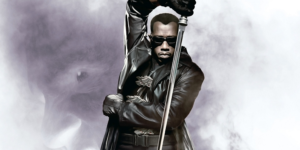
Being a movie about a half-vampire ninja dude that fights vampires, the movie is packed with action. Being a movie about a half-vampire ninja dude that fights vampires, the movie is also packed with comedy. While this is not an action-comedy, there is a near-perfect blend between the action and the comedy. The comedy doesn’t ever undercut the tension, but is in service to it. Donal Logue’s character of Quinn is a somewhat running joke of a vampire that seems to survive everything – and is the recipient of many one-liners throughout the film. However, that never actually removes his menace. It’s Blade sending Quinn to the hospital in the aftermath of the rave that dictates the action of the rest of the film. Quinn’s ability to survive means he wakes up on the gurney and bites the attending doctor – Karen Johnson – infecting her with vampirism and causing her to both work with Blade and seek a way to cure herself. Quinn – despite several more unfortunate-for-him run-ins with Blade – manages to survive and is instrumental in the capture of Blade for his boss’s big plan. This is a crucial lesson for all game-runners: Quinn is comic relief, but he is never not a threat. He remains an important part of the story and is dangerous for everyone who isn’t Blade – and ultimately is to Blade because of his history with him. It’s great to see.
It’s not just that one instance, either. When Blade and Karen go to the vampire archivist, Karen wields a UV floodlight to cause pain when Blade is interrogating Pearl the Record-Keeper. Karen burns Pearl over and over to get the information we need, in a scene that is truly gory and shows the meanness of Pearl’s nature. Blade instructs Karen to fry him if Pearl movies while Blade is looking through the records. Blade gets the information he needs, but Karen burns Pearl to death in a gruesome scene. When questioned about it, she opines, “he moved.” This is a good comic beat, but it occurs after the interrogation and scene with Deacon Frost. The tension and action are established. The use of comedy relieves the momentary tension, but not the greater tension established in the scene. It’s a great way to have your cake and eat it too.
Before moving on from this point, I just want to point out Blade encounters Deacon Frost during the day. Instead of Blade being able to kill him, Frost uses a little girl as an unwilling human shield. When questioned about how Frost can be out in the day, he just responds, “sun block.” This is obviously very humorous – Deacon slathered himself in sun block to have this conversation with Blade – and it’s ridiculous, but it doesn’t undercut the real threat that Deacon is posing to this child, heightened all the more by her lack of awareness. It also establishes vampires can do stuff like this, but it’s so much effort and so short-lived that it’s just not sustainable. This is a joke set within a moment of tension and drama that only goes to further the scene itself. It’s pure elegance.
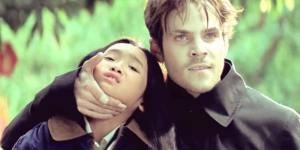
Speaking of Deacon Frost, let’s just jump into it. Deacon Frost is the best villain Marvel has ever put on film. The film part is important as I still haven’t watched Jessica Jones and hear the Purple Man is the best of the current generation. Thor: Ragnarok also isn’t out yet, but I can’t imagine I will do anything other than love every second of that film. Deacon Frost has clear, discernible goals, is willing to be flexible, and utilizes those at his disposal in a way that both furthers his desires while still inspiring loyalty. Importantly, he is an actual threat to the hero. His intelligence and planning is excellent, but his personal combat skills put him on equal footing with Blade at the beginning – allowing the idea of the increasing of those same powers to be a scary one indeed.
More importantly, Deacon Frost understand the need to change and adapt to the modern world. He’s Loki from the MCU if Loki had decided to work with white supremacists instead of exert outright mental control. The vampires are ruled by an ancient council and their ancient ways – in the tradition of vampire elders everywhere. These vampire elders don’t adapt or change with the times. This allows vampires created in the modern era to identify more closely with Deacon Frost. Frost understands that even if vampires don’t age, the world continues to do so. Computers are an ingrained part of society. Club culture allows for certain behaviors and uses. Controlling the infrastructure is a way to control humanity. He leverages this knowledge to rally younger vampires behind him with promises of a world where vampires are dominate. Their superior physical traits allowing them to make use of the technology of the world and take control of the humans, as long as they can move past that whole “sun” nonsense. That’s the story he is pitching to his followers and those who work with him. He’s got an answer for that problem, and he will lead his people to success.
To be fair, his plan works swimmingly. Blade ends up exactly where Deacon wants him to be in and in the condition he wants him to be in. He has solved the ancient riddle, manages to have the prophecy fulfilled, and is well on his way to achieving his goal as the new Blood God. The only thing that stops him is an illustration of his previous demeanor in action. Deacon abandons the new, modern approach that made him successful for ancient ways and magic. This magic is overcome through a scientific solution, just as the ancients were overcome by him. It’s Chekhov’s Blood Coagulant. While a smidge silly, it’s much better and more thematically appropriate than the Loki nonsense in Avengers or even the resolution of Spider-Man: Homecoming. Deacon remains a threat from start to finish, and only through luck and a betrayal of his own ideals is he brought down. Sure, our hero wasn’t going to die, but that also wasn’t the only stake (heh) at hand. He could have lost his humanity. He could have betrayed his own ideals. He could have failed, but ultimately salvage victory.

This is what you want out of the villains you portray. Deacon isn’t showy for the sake of being showy. He’s showy to further his goals. His henchmen aren’t useless. They are good at doing specifically what they should be doing. He doesn’t get set in any one method or plan. It’s multi-layered, but not accounting for every single angle. He’s smart and competent, but not an infallible super-genius. He’s a constant threat to Blade, but the threat isn’t only physical. He also would genuinely work with Blade in order to further his own goals. The temptation and offers are very real. This all combines to make a memorable, threatening villain. He’s doing this to make the world better for his people – albeit by also making himself a god. He can be a megalomaniac and also have some ideals, after all. This is absolutely the type of villain you want in your games. Someone who has this level of clarity and threat. Sure, he might be defeated – but he is going to challenge the hero every step of the way, and always in ways that both make sense and continue to provide threat.
Despite all of the information that has been laid out as to how Blade is both a great movie and one of the better ones to draw game lessons from, I know that people will attempt to convince me there are better Marvel films out there to look at and write about. I’m always looking to re-watch things and learn new lessons, but you should all know it will be a struggle for me to believe otherwise. Still, I doubt this will stop people from telling me how wrong I am.
Some motherfuckers always tryin’ to ice skate uphill.

